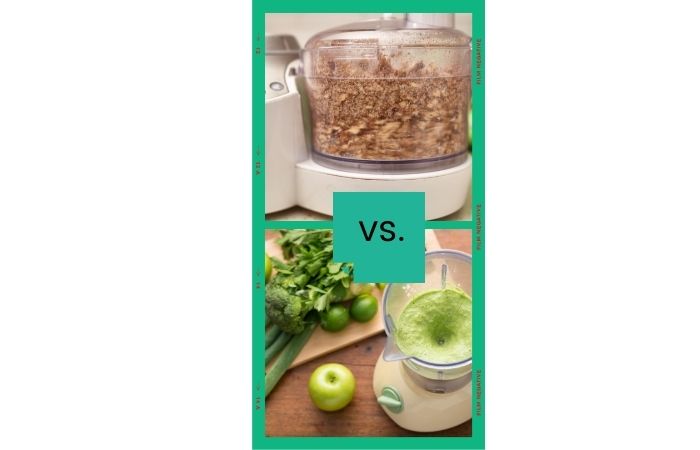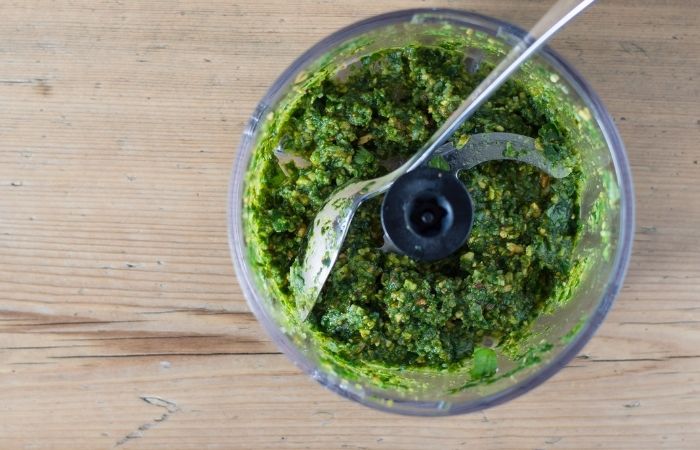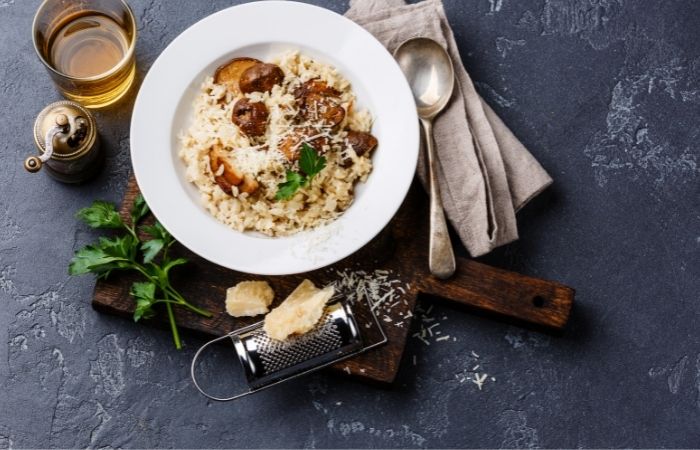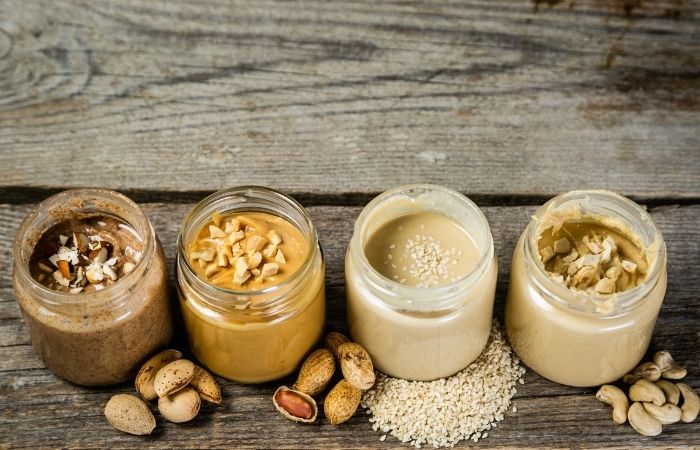Today, we’ll discuss the main differences between a food processor vs. blender so you can decide which one is best for your needs. We’ll also go over some of their most common uses in detail, so you know when to use each appliance. Let’s get started!

Food processors and blenders are both kitchen appliances that can be used to make a variety of dishes. However, they do have some essential differences that set them apart from each other.
What is a Food Processor?
A food processor is an electrical appliance with a rotating blade and discs of different sizes for slicing, grating, mixing, pureeing, and kneading dough. It can also be used to shred vegetables when the appropriate disc attachment is used.
Food processors are within the central processing unit (CPU) family of appliances. In other words, they are a type of computer. An electronic control board monitors the appliance’s processing time and power supply to shut itself off when necessary.
Compared to blenders, food processors have the largest feeding chutes in the industry at over two inches wide, which makes them a necessity for recipes that require a lot of prep.
What Does a Food Processor do?
A food processor is a popular choice for people who love to cook because it can efficiently chop, slice, grate, and puree almost any ingredient. So whether you want to make your salsa or finely grate some Italian cheese, a food processor is one of the most versatile appliances in your kitchen.

Food processors are made to handle time-consuming tasks such as kneading bread dough, pastry crusts, and even grinding nuts. Food processors are also suitable for shredding vegetables into small pieces, which are incredibly helpful when making coleslaw or salads.
A food processor can save you time because it is capable of completing multiple tasks at once. It can chop vegetables while mixing cake batter, whipping up cream, or kneading dough.
Some food processors come with attachments that make uniform slices, crinkle cuts, or french fries. These attachments are also excellent for creating uniform pieces of fruits and vegetables for salads.
Food processors come with many different blades and disks, allowing you to cut, shred, blend, and knead your food.
Some common things processors do are to:
- Chop, slice, and grate vegetables and other foods.
- Mix dough for baked goods such as bread, pizza, and pastry.
- Blend liquids and sauces to create smoothies, dips, salad dressings, and more.
- Mix the ingredients, so they are even in size.
- Puree food to make it smooth and creamy.
- Create dough by mixing the ingredients into a ball.
- Creating dough for baked goods such as pastry, waffles, and bread.
- Liquidizing purees and soups to make them smooth and creamy.
- Cutting meats into small pieces for stews or ground meat for dishes like meatballs or burgers.
- Grating cheese, carrots, and other foods.
What is a Blender?
A blender is an appliance that comes with a rotating blade that’s powered by an electric motor. They are used to blend, purée, or liquefy ingredients for drinks, salads, desserts, and more. The blender blades rotate at 8,000-35,000 RPM speeds, working more quickly than food processors.
Blenders can also be of different sizes and types, including conventional and immersion blenders. A conventional blender has a large glass jar that sits on top of the base, while an immersion blender comes with a large cup or jug that’s attached to a rotating blade at one end.
What Does a Blender do?
Blenders are most commonly used to make liquids, smoothies, and milkshakes. However, some blenders can also crush ice, so they are great for making frozen drinks in the summertime. They can also be used to purée ingredients for soups, sauces, dips, and spreads.
A blender is usually less expensive than a food processor, making it the more popular choice for people who don’t use it. Also, blenders are much easier to clean than food processors, so they save you time in the long run.

Some everyday things a blender can do:
- Make pureed soups and sauces such as guacamole and hummus.
- Liquefy solid ingredients into liquids such as frozen fruit and ice.
- Make smoothies filled with fresh fruits, vegetables, yogurt, and other ingredients.
- Crush ice for drinks such as margaritas, daiquiris or piña coladas.
What is the Difference Between a Food Processor vs. Blender?
Use
If you’re making pizza dough, pie crusts, crackers, or breadsticks, then a food processor is the appliance to use.
They can produce dough in very little time, which makes them ideal for commercial kitchens as well. Blenders are mainly used for beverages, smoothies, or purées. They can also be used to make salad dressings and mayonnaise, but you’ll need some skill and experience before learning how to do it.
Price
Food processors are typically more expensive than blenders, but they can perform much more than blenders. If you plan to use your appliances for different tasks throughout the year, it might be worth investing in both.
However, if you don’t think you’ll need either one or you don’t want to spend that much money, then a blender may be all you need.
Cutting blades
The blade on a blender is made from a single piece of metal attached to a handle. The container only covers the blades, so they need to be washed after each use.
On the other hand, food processors have removable blades that can be removed, washed, and resharpened when needed without replacing the entire appliance.
Speed
If you’re looking for a blender that has the highest speed, then you should check out blenders with between 100 and 200 watts of power, as they are typically the fastest.
Food processors come in various speeds, but they can be as fast as 450 watts, about half the speed of a powerful blender.
Cleaning
Blenders are easier to clean than food processors. You can blend some dish soap, water, and ice cubes in the container to make sure all of it is cleaned before you take it apart.
Cleaning under the blades is not easy with a food processor, so they should be washed more carefully.
Some people also complain that the soup or sauce they make with their food processor is never as smooth as it can be because the blades become dull after a certain period of time.
Size
You might think that blenders are typically smaller than food processors, but this isn’t always the case. Food processors can range from 8 to 20 cups, while some smaller countertop blenders are only 1 to 2 cups. However, this mainly depends on the manufacturer.
Performance
Blenders are typically not as powerful as food processors, so they should never be used to blend harder ingredients such as ice or nuts unless you’re preparing a drink or smoothie. If you want to make nut butter or grind meat, you should get a food processor instead.
Food Processor vs. Blender – Which One to Buy
If you’re looking to buy an appliance that can chop, slice and shred your ingredients or process dough quickly, go for a food processor. But if you need to liquefy solid ingredients into liquids such as frozen fruit and ice to make drinks or smoothies, opt for a blender instead!
Similarities Between a Blender and a Food Processor
A blender and a food processor both come with electric motors that work to power the rotating blades. They can both be used for chopping, slicing, and shredding ingredients such as vegetables and cheese.
They can both be used to make pasta dough, but a food processor does it faster. Blenders and food processors also have interchangeable blades for different tasks. Below are some common similarities between a blender vs. food processor:
- Both have blades and containers.
- Can chop vegetables, mix the dough and blend liquids.
- Utilize electricity to power the appliances.
- Come with different sized blades and containers to make varying amounts.
- Both have that come with touchpad controls.
- Come in various sizes.
- Use similar ingredients, such as fruits.
What to Make in a Food Processor
Bread and Pizza Dough
Food processors are much better at making dough than blenders, so you should consider buying a food processor if you want to make pizza for your family. Not only will it save time, but the texture of the pizza crust is also much better when it’s made in a food processor.
Chips and Salsa
Pre-made chips and salsa can be pretty expensive, so you might want to make your own instead. To do this, all you need is a food processor and fresh ingredients such as tomatoes, onions, and cilantro.
Salsa also has many variations that you can try with your food processor, like mango chutney, red onion salsa, and guava-pineapple salsa.
Soups and Baby Food
Any soup can be made in a food processor, but you should consider choosing one with a high-performance motor since they are better at processing harder ingredients. Babies cannot eat solid foods until they’re between 4 to 6 months old, so if you want to make healthy, organic baby food, you should use a food processor instead of a blender.
Sauces and Seasonings From Pasta to Risotto
Tomato sauce, meat sauce, vegetable ragu, pesto, walnut sauce, practically anything with a food processor can be prepared, even if it is your first time cooking. A food processor can also be used for preparing salad dressings.

Doughs for Meatballs and Burgers
A perfect breadless burger awaits you; it’s even possible to make vegan burgers with a food processor. The ideal dough must be mixed until it gets sticky; if not, the meatballs will fall apart in the pan.
Smoothies, Yogurt, Sorbets
A food processor is the best appliance for making creamy and smooth dishes, like yogurt or sorbets. You can even make drinks such as milkshakes or smoothies.
Jams and Creams
Food processors are perfect for making jams and creams without needing to boil or cook them. The appliance can mash up fruits so you can prepare jam within minutes–although it is best if you know your fruit’s ripeness.
Ice cream, Popsicles, and Sorbets
A food processor quickly makes ice cream, popsicles, and sorbets, although it needs to be done a little bit in advance because of the required time for freezing.
What to Make in a Blender
Smoothies, Margaritas, and Milkshakes
The only reason you would need to buy a blender is to make fruit smoothies or milkshakes, so if this sounds like something that’s up to your alley, then go for a blender instead. If you want to make a margarita or daiquiri, then a blender is your best friend.
Smoothies are also a great way to get more fruits and vegetables into your daily diet so if you love smoothies but think they’re too expensive from the store, try making your own using a blender.
Nut Butter and Milkshakes
If you want to make nut butter or milkshakes, you should go for a blender even though it can’t process hard ingredients as food processors can. However, one crucial thing to note is that blenders cannot be used for liquids, so they can’t process frozen fruit, so if you want to make a milkshake, then blend the ingredients first and add crushed ice later.

Homemade Mayo
If you’re looking for a healthier alternative to store-bought mayo because it has many additives and preservatives, then prepare your homemade mayo in a blender instead of a food processor.
Mayo can be made with a blender in minutes, and it’s a great way to use up any vegetables that might have gone wilted, so go ahead and blend those carrots, garlic, and onions for some tasty mayo.
Fruit and Vegetable Juices
A blender is ideal for making fresh juice from any fruit or vegetables you fancy. With a blender, you get a better texture compared to a food processor. You can even add ice cubes if you want a cool drink.
Smoothies, Soup, Ice cream, and Hot Drinks
The best way to make hot drinks with a blender is by pouring the ingredients into the container before you start blending. You can also use it for making smoothies or vegan shakes.
Pesto, Hummus, Pesto Sauce
Blenders are perfect for making pesto, hummus, pesto sauce, peanut butter, and pureeing vegetables.
Dressing and Pancake Batter
With a blender, you can prepare homemade dressings in minutes. You can also make pancake batter since they don’t need to be as thick as doughs.
Foods/Drinks Not to Make in a Food Processor
Mayo, Cheese Balls, and Crackers
A food processor is usually associated with cooking doughs or processing hard ingredients like vegetables. Still, if you want to prepare a vegan cheeseball or crackers, then you can’t use a food processor for that since it won’t process dough well.
Sauces, Purees, and Hummus
Food processors are not the best appliance for making purees or hummus because they usually leave a yucky aftertaste. If you want to make hummus, then use a blender instead!
Foods/Drinks Not to Make in a Blender
Dough
If you want to make dough with a blender, then forget about it. Blenders don’t process flour, and if you’re going to make pizza dough, pastry, or even bread crumbs, you should use a food processor instead.
Frozen Fruit
Adding ice cubes or frozen fruits to a blender will most likely stop the blades from rotating, so use crushed ice instead.
Tofu
Blenders (and many other appliances) are not the best for making tofu because it’s so messy. If you have a high-power blender, you can give it a try, but use your food processor for this job if it doesn’t work out.
FAQS
What’s the difference between:
Food processor vs. hand blender
A food processor is better for more complex ingredients, while a hand blender (or immersion blender) is ideal for soups and dressings.
Ninja blender vs. food processor
A Ninja blender is a powerful machine that can make dough. However, a food processor is better for making dough since it has stronger blades.
High-speed blender vs. food processor
A high-speed blender is ideal for making smoothies and milkshakes, while a food processor is better for harder ingredients.
Conclusion
A food processor is great if you need to quickly chop, slice, or shred large amounts of vegetables or cheese. You can use it for making dips, spreads, and salsas but avoid using it for blending liquids, making dough, or pureeing vegetables.
A blender is excellent for liquefying ingredients; you can use it to make smoothies, including frozen fruit and ice. In addition, the blender works well for crushing ice and making homemade baby food. You can also make salsas, dips, and spreads in a blender but avoid using it when making dough or chopping vegetables.

Community of passionate writers and content creators who share a love for Italian heritage, culture, travel, food, and the Italian-American community. Our mission is to celebrate Italy’s rich history and traditions and connect with others who share the same passion.

